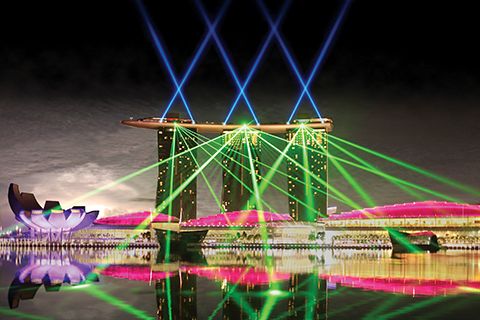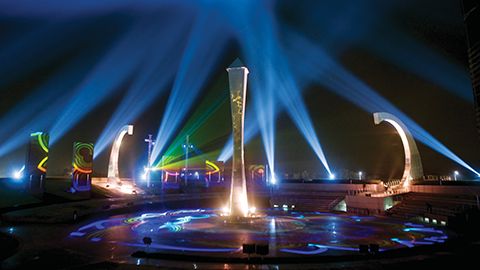Marina Bay Sands Resort
When Singapore’s Marina Bay Sands Resort opened in 2011, it represented the world’s most expensive stand-alone casino property, costing approximately $6 billion U.S. Instead of projecting videos onto the resort’s three towers or the Skypark that tops them, however, water vapour from the bay itself serves as the focal point for a nightly public light show.

Water and buildings are among the many surfaces illuminated in a 360-degree show at Singapore’s Marina Bay Sands Resort. Photos courtesy Christie
Reinforcing the resort’s position as a primary leisure destination, the multimedia show—the largest of its kind in Southeast Asia—combines water cannons, light-emitting diode (LED) illumination, fireworks, lasers and an original 13-minute symphonic score to tell the story of life and humanity. Projected video and motion graphics metaphorically trace life from childhood to old age.
“The show is designed to make us stop, take stock of our lives and appreciate the natural beauty and wonder around us,” says Michael Leven, former president and chief operating officer (COO) of Las Vegas Sands, which owns the resort (he recently became president and CEO of the Georgia Aquarium).
The production took more than three years to develop, between technology design, presentations and government approvals.
“There are challenges because this is a 360-degree show around the bay,” says Paul McCloskey, CEO and founder of Laservision Mega Media, which produced the show. “You have media in front of, behind, above, below and beside you both left and right. You are basically inside a 3-D fantasy, with the media enveloping you, so you become immersed in the experience.”
The equipment behind the show includes seven projectors that illuminate the water vapour ‘screens,’ 15 laser systems, 30 moving searchlights, 250,000 LEDs illuminating the buildings, spotlights, strobes and pyrotechnics.
The show has already been seen by millions of visitors and residents and rated one of Asia’s top new tourist attractions.

The Guru Tegh Bahadur Memorial in New Delhi, India, features the region’s largest projection mapping installation, Panchtatva: The Five Elements.
Panchtatva: The Five Elements
While the aforementioned Love of Delhi was India’s first permanent projection mapping installation, it certainly isn’t the country’s only eye-catching project. New Delhi’s Guru Tegh Bahadur Memorial, built to celebrate the life and teachings of the Sikh’s ninth guru, was launched later the same year (2011) and is now the largest permanent projection mapping installation in the region.
The focal point of the memorial site is an obelisk, surrounded by semi-arches and monoliths representing disciples and gurus. At first, the site struggled to attract paying visitors, but that changed after the addition of Panchtatva, a nightly show that floods the obelisk with light and motion graphics representing the five elements of nature: air, water, fire, earth and space.
“The client wanted universal appeal to target a large diaspora of tourists,” explains Himanshu Singh Sabharwal, creative director for Tricolor India Schauspiel. “I knew we could not tell a linear story here, but I got the idea of creating a musical tribute to the five elements and the guru, which lent itself to a more fluid experience, which was perhaps the only possible option here.”
Mike Garrido is a senior product manager for Christie, which manufactures digital projectors. This article is based on the company’s publication, The Book of Transformations, which recently won the gold 2015 Digital Signage Expo (DSE) Apex Content Award in the multi-platform category. For more information, visit www.christiedigital.com.





